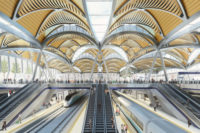Three serviceable office blocks are being torn down at London’s Euston railroad terminus to make way for the new high-speed line HS2. Phase One of the $74-billion program has secured necessary approvals, lined up its main civil contractors and already consumed more than $6 billion of government investment. But even before construction starts, the sponsor is already struggling to keep within budget.
Asked by a recent parliamentary committee what Phase One from London to Birmingham would cost, Terry Morgan, the former chair of the sponsor HS2 Ltd. (HSL) answered “nobody knows yet.” Design/build teams are searching for economies to bring target costs within the $35.5-billion budget, including rolling stock, before construction can start of the 230-km line.
To be built in three phases, HS2 is planned by 2033 to connect London with Manchester and Leeds, via Birmingham, the East Midlands, Sheffield and Crewe. Phase One between London and the West Midlands was due to be in construction this year with a 2026 completion date. It includes more than 8 km of cut-and-cover work and around 40 km of twin-bored tunnels with 7.55 - 8.8 m internal diameters.
When HS2L named preferred bidders for some $8.7 billion of Phase One civil work in July 2017, the contractors were expected to complete necessary design and preparatory work to firm up target prices and sign design/build contracts by the end of last year.
However, before then, HS2L acknowledged that, because of “cost pressures” another 12 months was needed achieve the $32-billion budget for fixed infrastructure, land acquisition and real estate compensation, says an official.
Among the biggest contract winners was a team of London-based Balfour Beatty Group Ltd., with units of Vinci Group, Paris. They won two contracts totaling $3.3 billion for the line’s northern third. Other continental European winners, in joint venture with local firms, included Austria-based Strabag A.G., and the French groups Bouygues and Eiffage.
Cutting costs by reducing the line’s operating specification is not an option, according to Clive Maxwell, the Dept. for Transport’s (DfT) head of high speed and major railroad projects. HS2L’s chief executive Mark Thurston had previously identified to lawmakers that reducing train speeds and their frequency, and the use of ballast instead of concrete slab rail supports, were hypothetical cost saving measures.
The line’s planned frequency of 18 transits per hour each way is based on the signaling system’s capacity of one train every 2.5 minutes reduced by a 25% safety margin, according to Nick Bisson, DfT’s director HS2’s next phase, 2a. Reducing speeds from 360 to 200 km per hour would cut costs by around 9% while slashing 30% off the economic benefit, he added.
To alter significantly the line’s specification would undermine HS2’s essential business case to justify the huge investment. The program’s first business case was completed in 2013 and finally updated in 2017, according to Bisson. A further update must be made this year before Phase One work can begin.
Still bearing “all the scars of Crossrail,” Morgan commends the integrated approach being used in the quest for cost savings with HS2’s contractors. He was forced to resign from chairing London’s $20-billion Crossrail project company in December when the scale of schedule and cost overruns became clear (ENR 12/17/2018 p. 8). At the same time he quit as chair of HS2L, after five months on the job.
On HS2, the “whole approach to looking at all seven major civil contracts… is based on coming up with a model that has greater collaboration and standardization,” added Morgan. “That was part of the learning from Crossrail. It might sound obvious to say standardization, but when you are placing a contract with one company, it wants to do (the work) its way.”
Big cost uncertainties over HS2 have fueled persistent criticisms of such a costly high-speed system in a small country like the U.K. HS2 is a “white elephant,” according to David Davis, a former senior minister in the Conservative government. The money allocated to the program would cover the cost of replacing all the U.K.’s rolling stock twice over with “change to spare,” he claims.
However, the government is putting forth enabling legislation for the $4.6-billion phase 2a up to Crewe, and plans start the permitting process for the rest of the program to the north, valued at $33.8 billion, in June 2020. The promoter regards HS2 as essential infrastructure, which, according to the minister for railroads, Andrew Jones, is already supporting 7,000 jobs even before the main construction starts.





Post a comment to this article
Report Abusive Comment